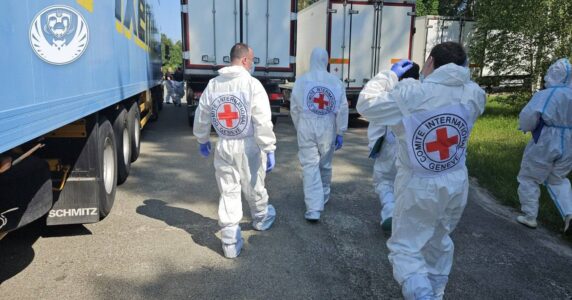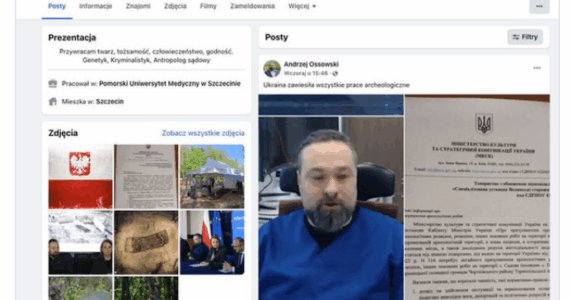Navigation and useful materials
Russian propaganda is trying to sow panic after the attack on Khmelnytskyi on May 13. To this end, they invented a message about a “radiation catastrophe.” Moreover, disinformation was disseminated in Russia, in Ukraine, as well as abroad, for example, in Poland, Moldova, India.
Stating, it was almost like a new Chornobyl catastrophe. Thus, The New Indian wrote: “A series of explosions at an ammunition depot in western Ukraine has led to a significant increase in gamma radiation levels, suggesting the release of depleted uranium dust into the air.… Residents have expressed panic and are reportedly gathering their belongings and leaving the affected areas, including Khmelnytskyi, Lviv, and Ternopil.”
As far as Poland is concerned, propaganda telegram channels tried to combine the narrative about the “catastrophe in Ukraine” with photos from radiation and chemical safety exercises that were actually held in Poland.
On May 19, Secretary of the Security Council Patrushev joined the launched disinformation campaign, who tried to frighten the population in Europe. He said that the radioactive cloud, which arose after the destruction of depleted uranium ammunition supplied to Ukraine, was approaching Western Europe. He mentioned Poland, which had allegedly “recorded an increase in the radiation level” and said that in the near future, the cloud “will reach the borders of Germany, France, and Switzerland.”
Polish fact-checkers quickly discovered and exposed the fake. On May 15, it was reported that the Polish National Atomic Energy Agency had not detected any radiation hazards in Poland.

Moreover, the Poles noticed that the comments under this post repeated messages that intensified the panic: “Swallow iodine quickly!” “Again, like with Chornobyl, we will be the last to know…” The same comments about iodine and Chornobyl were written like on Khmelnytskyi websites.
Consequently, the Kremlin continues to build up its disinformation narrative about “terrible depleted uranium,” which appears to be more practical for propaganda than fiction about the “US bio-laboratories” in Ukraine.
READ ALSO: How and Why Russian Propaganda “Looks” for US Biolabs in Ukraine and the World?
In March of this year, almost the entire Kremlin clique, ranging from “diplomats” — the Russian Embassy in Britain, Zakharova, Lavrov — and to Shoigu and Putin, alternately depicted “righteous anger” about the supply of the shells, saying that Russia “is forced” to respond. At the same time, on March 21, Putin once again repeated his phrase from the genocidal lexicon about “war to the last Ukrainian.”
As you know, shells with a depleted uranium rod are used not for nuclear reaction, but as a material with high hardness. They are permitted by international conventions. However, Putinism manipulates the word uranium, which at the everyday level is associated with nuclear weapons and radioactivity. It is also part of the information agenda of various “peace fighters,” whom the Kremlin uses in the hope to weaken military assistance to Ukraine.
In fact, already in March, the Kremlin justified its decision to deploy nuclear weapons in Belarus with stories about the fictional nuclear danger — a real step towards the proliferation of nuclear weapons in the world, which undermines the principles of the 1968 Non-Proliferation Treaty.
Russia regularly resorts to threats of the use of nuclear weapons against Ukraine and its partners. An unprecedented act of nuclear terrorism is Russians holding the Zaporizhzhia nuclear power plant and the deliberate creation of emergency situations on it. Therefore, the message about Western “almost nuclear shells” is an attempt by the aggressor to present itself as a victim. As it was with the “dirty bomb” stories.
READ ALSO: “Dirty Bomb” Is Back. Why Russia Retrieved the Old Story
Interestingly, in its information campaign in March, the Kremlin relied on the words of British Deputy Minister of Defence James Heappey, who responded to the request of Kenny MacAskill, an MP from the Scottish party. The media reported on the speeches of MacAskill on Russia Today with the propaganda of separatism in Scotland. In 2017, unlike many others, he supported the decision of politician Alex Salmond to launch his own show on Russia Today and gave him interviews.

Unfortunately, the PSYOP about the alleged surge in radiation due to the explosion in Khmelnytskyi became the reason for the hype of individual politicians. Thus, former MP Ihor Mosiichuk played into the hands of Russian attempts to spread panic with his statements about the need to evacuate children.
The origin of these messages was inadvertently disclosed on Russian TV. “They outsmarted themselves, is that why they started talking about this uranium? asks the information criminal Sheynin in his show. “Have we learned how to work in a way that we can put this panic in their heads?” “Yes, we have,” admits another criminal propagandist, Kozakov.
Earlier, on March 28, the Centre for Strategic Communication recorded that the topic of radioactive shells began to be promoted to the Ukrainian audience. The fake “Memo of a soldier of the VSU” (instead of ZSU; ZSU being the Ukranian abbreviation, VSU being Russian) with a mention of the “beneficial effects of radiation on human health” was put on advertising through Facebook for the Ukrainian audience to fuel rumours about a radiation leak.

The journalist of vsim.ua checked the data on the level of radiation in various communities of Khmelnytskyi Oblast on SaveEcoBot immediately after the shelling and established the dynamics of changes in indicators from 09:00 a.m. May 12 to 09:00 a.m. May 13. Throughout the region, the result was as follows: at 7 observation points, a decrease in the level of radiation was recorded, at 10 points — an increase, at another 7 — the indicators remained unchanged.

“In Khmelnytskyi, the level of exposure dose of gamma radiation was 0.12 microsieverts per hour before shelling and 0.14 microsieverts after shelling. This measurement point is the closest to the point of the attack. In the Ruzhychna territorial community, the radiation level before the shelling was 0.15 microsieverts, and after — 0.12. This measurement point is the second farthest from the place of shelling,” the journalists stated.
The head of the Department of Ecology of Khmelnytskyi National University, Nataliia Mironova, said that these are absolutely insignificant fluctuations within the statistical error, which are much less than the permissible norm: “These are insignificant fluctuations. It is simply a common standard value of up to 0.3 microsieverts per hour. We have such areas that can have up to 0.2 microsieverts per hour, but this is still considered within the norm. 0.12-0.14 is a small change.”
The fluctuations within the norm are also indicated by the Radioactivity Environmental Monitoring of the European Commission.

But Russian propaganda tried to spread panic, passing off the fluctuations in the statistical error for the catastrophe. Although in practice, this can be compared with someone saying about the danger of the temperature increase in humans from 36.5 to 36.6.
For the attentive audience that checks the information and figures, the propaganda resorted to another argument: “although the radiation background is low, but you will feel the consequences in a few years.” Stating that was the case in Serbia and Iraq.

These information plots already have their own history. More than 20 years ago, in 2001, the then young Putin regime, which had just reached power in Russia, began to criticize the West because of its “harmful weapons” in Yugoslavia. “We are surprised that NATO countries are only now talking about the ecological damage wreaked by their aggression,” Russian Nazi Dmitry Rogozin told CNN. At the same time, a whole information campaign was launched in the world about the harmfulness and need for verification of depleted uranium shells.
It is significant that the Khmelnytskyi attack coincided with the publication of a material with historical parallels in the state newspaper Rossiyskaya Gazeta: “Serbian Diaries: Uranus for the Slavs. After the ‘Uranium’ Bombing of NATO, Serbia Became the Leader in the Balkans in Cancer Deaths.” Danica Grujičić, Serbia’s health minister, played into the hands of their narratives in an interview with Russian propagandists. “If they use them in Ukraine, you should consider it a nuclear war.” “Sending such shells to help Ukraine? Ukrainians will be the first to suffer from this!”
Back on April 3, 2023, Ms. Grujičić began voicing pro-Russian messages in the Ukrainian context: “This is poison: the Serbian Ministry of Health called on Kyiv not to use depleted uranium shells,” she told TASS. For some reason, the minister did not appeal to Russians to stop destroying Ukrainian cities and killing people.
It is interesting that, according to information in Wikipedia, Ms. Danica Grujičić graduated from the secondary school in Moscow in 1976. In 2018, she headed a commission to “identify the consequences of NATO aggression in 1999 for the environment and health of Serbian citizens.” On October 26, 2022, she was appointed Minister of Health of Serbia.
Rafael Grossi, the head of the International Atomic Energy Agency (IAEA), made a clear statement about depleted uranium shells on March 29, 2023: “This weapon does not pose a radiological hazard.” He added that the issue of the use of ammunition using depleted uranium and the accompanying effect on human health have been studied by the IAEA for quite a long time.
The statistics of the incidence rate also depends on whether the disease is identified: the better the diagnosis, the more patients per 1,000 inhabitants are detected. And therefore, an increase in the indicator of statistics may be the result of a change in approaches to diagnosis.
Thus, the participation in the promotion of the narrative about depleted uranium personally by Putin and Patrushev, PSYOP on the topic of the fictional radiation surge in Khmelnytskyi, its dissemination through the disinformation network both in Ukraine and in the world, the presence of “historical background” with reference to NATO actions indicate that “depleted uranium” is becoming the new favourite narrative of disinformation, instead of bio-laboratories. Russia is using it to justify its own nuclear blackmail.
Kremlin special services are trying to intimidate Ukrainians and Europeans. But judging by the hysteria of the propagandists and the uncertainty of Russians, it is they who become more frightened because, subconsciously, they feel that the regime will not reckon with their opinion before a possible nuclear escalation.
Centre for Strategic Communication and Information Security
The media version can be found on the UP website
If you have found a spelling error, please, notify us by selecting that text and pressing Ctrl+Enter.


